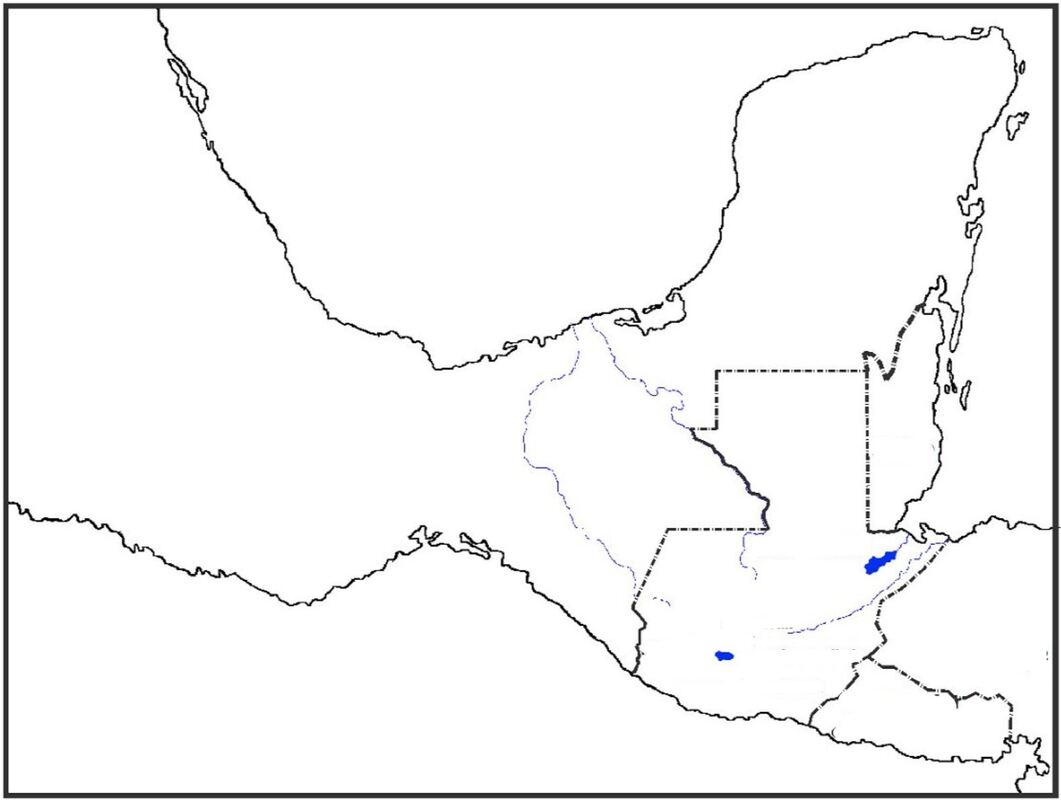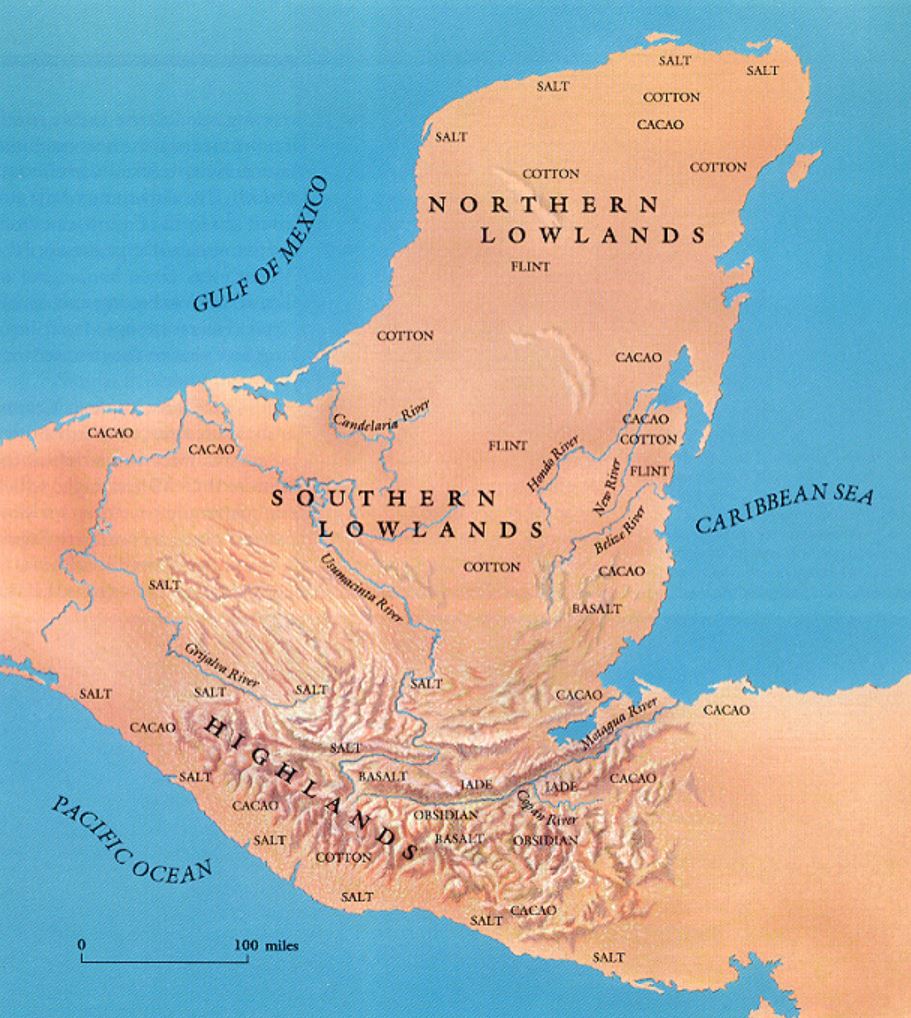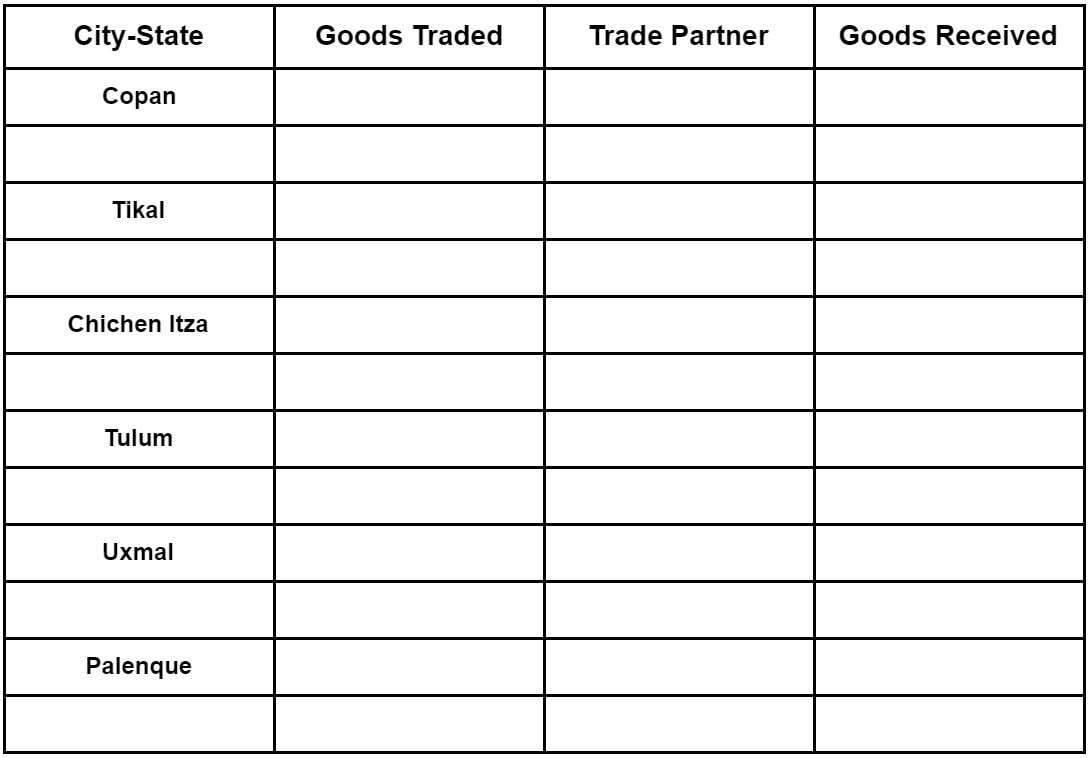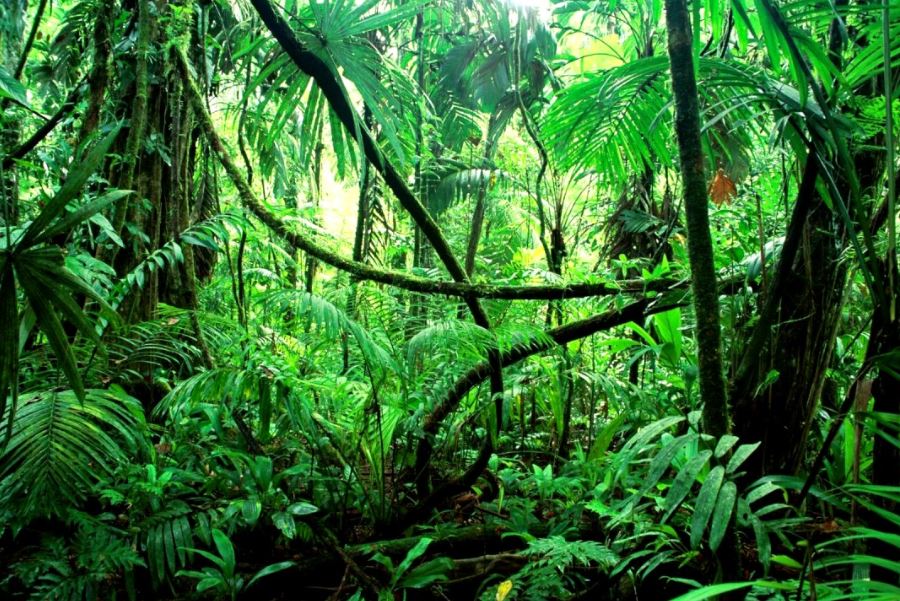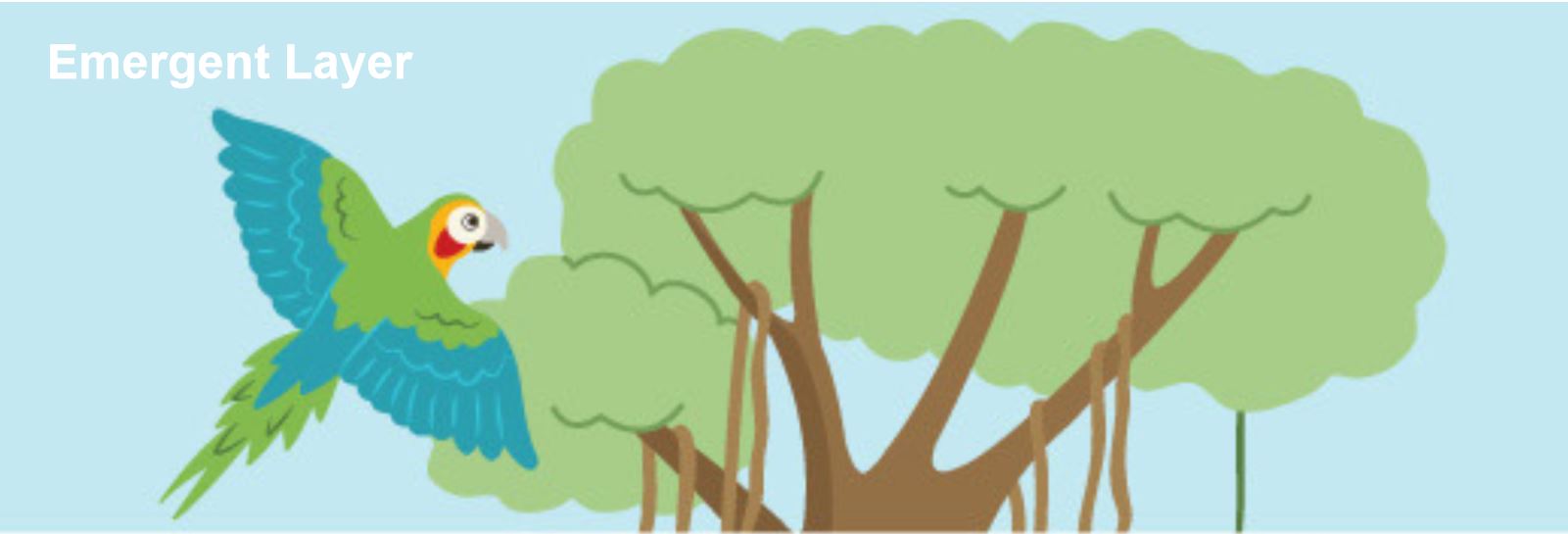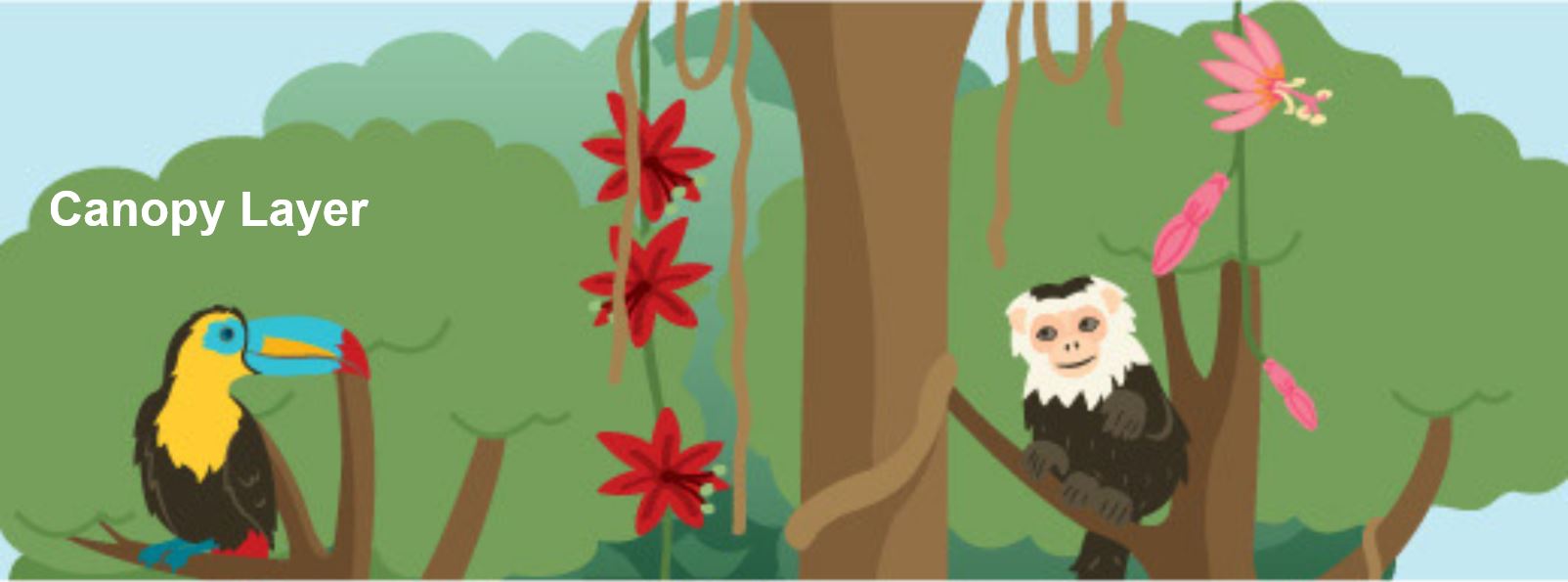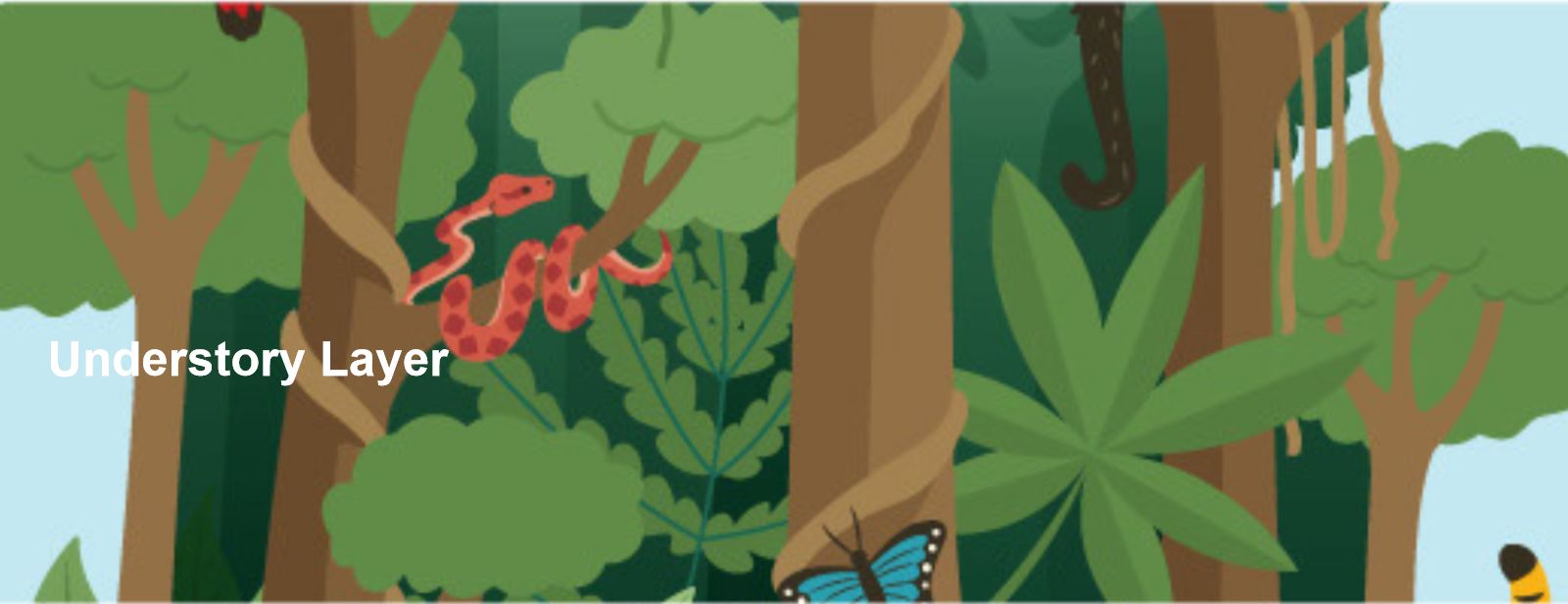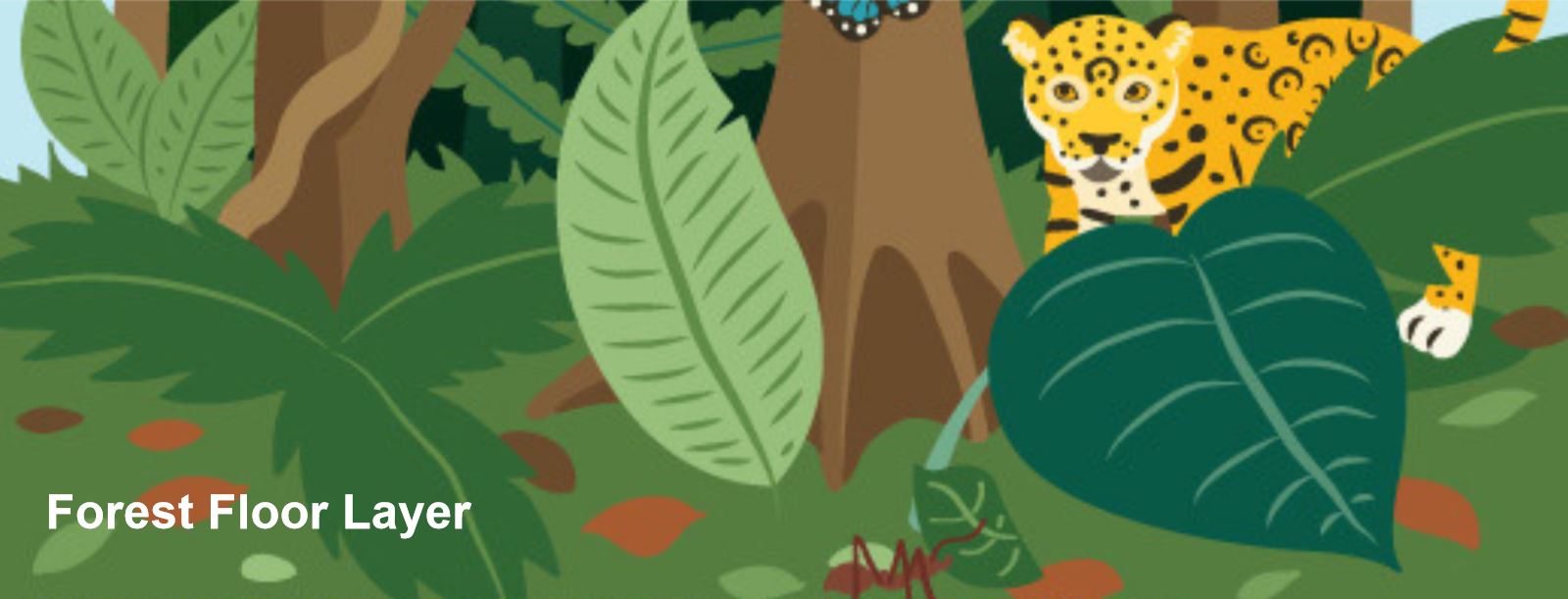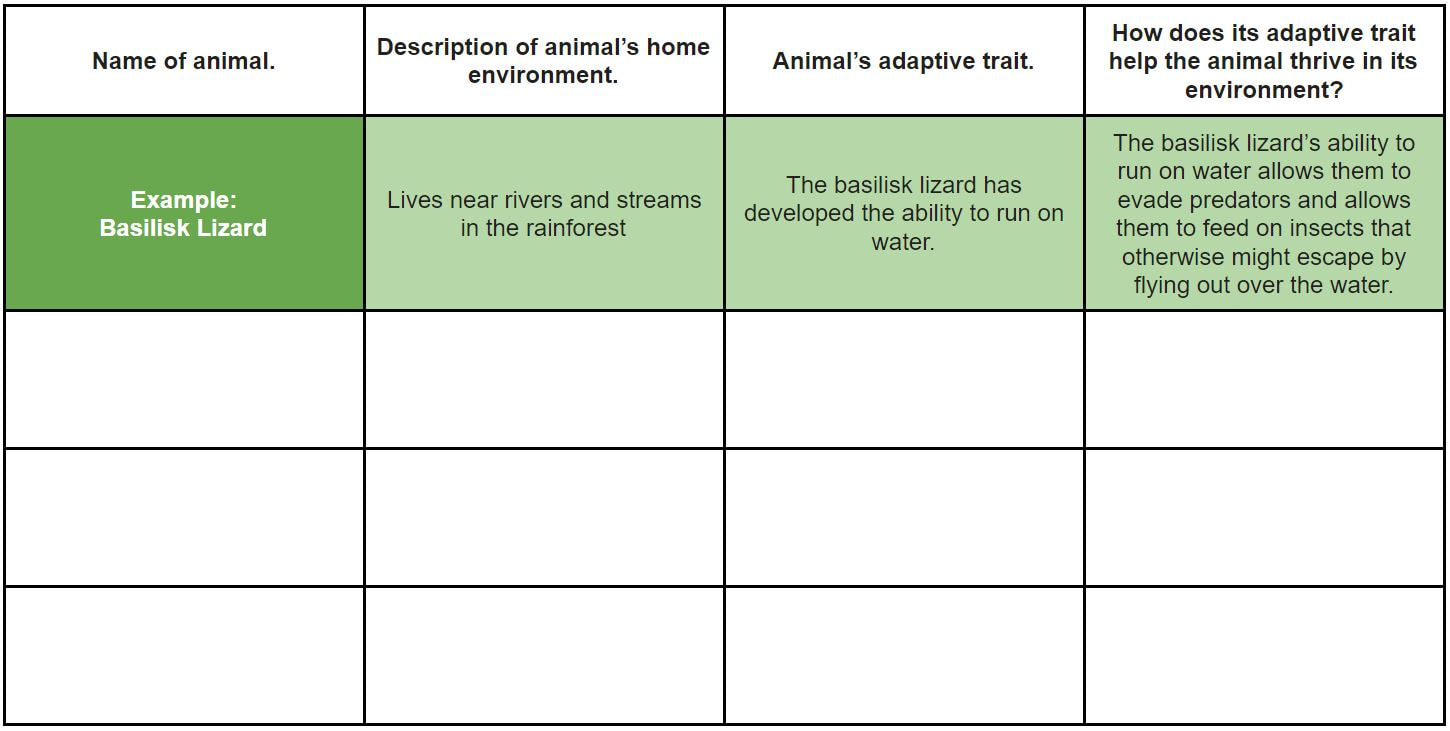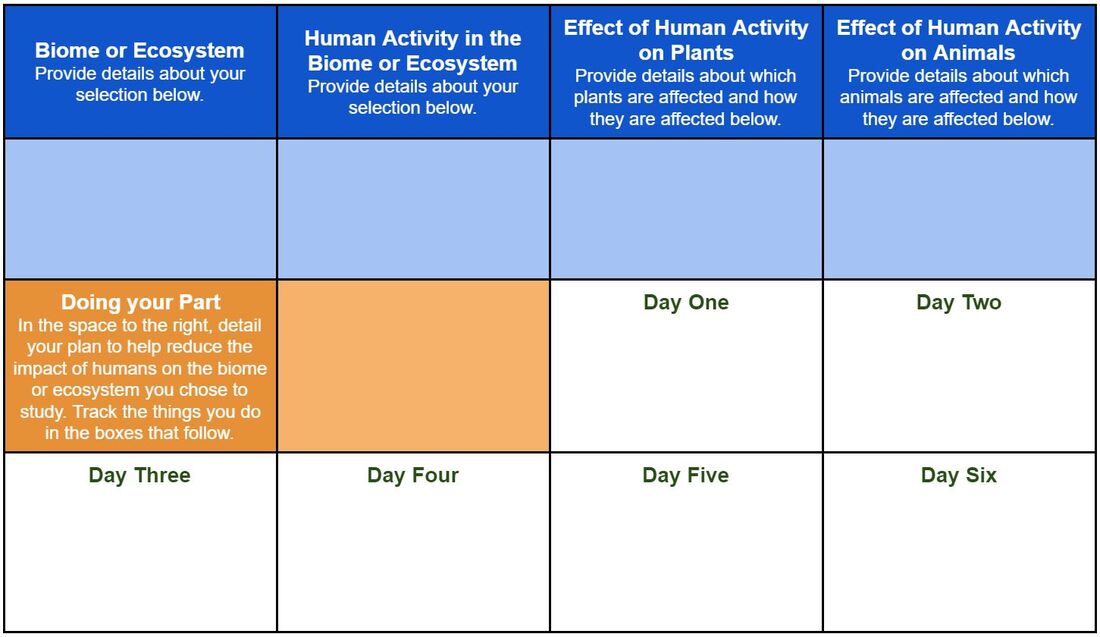Maya Geography Activity
Going to the Map for the Environment
Going to the Map for the Environment
Nearly 2500 years ago the Maya began building their civilization in the rainforest of Central America. To this day, it's a challenging environment in which to live. And yet, the Maya built the largest, longest lasting of the Mesoamerican civilizations. Millions of people still call the land once occupied by the Maya home.
For this geography activity, you will map the area of Maya settlement, identifying major Maya city-states and the modern countries in which they existed.
For this geography activity, you will map the area of Maya settlement, identifying major Maya city-states and the modern countries in which they existed.
On the map above, label the following: Yucatan Peninsula, Pacific Ocean, Gulf of Mexico, Caribbean Sea Modern-Day Countries: Mexico, Guatemala, El Salvador, Belize, Honduras Maya Cities: Copan, Tikal, Chichen Itza, Tulum, and Uxmal.
Trading PlacesAs the Maya civilization grew they developed an extensive trade network. Use the map you completed above, as well as to the left and online resources, to complete the chart below.
Remember that trades are made because each partner has something the other needs. Identify at least two trades for each city-state listed in the chart below. |
Home Sweet Biome
Biome - noun: A biome is a specific environment that's home to living things - plants and animals - suited for that place and climate.
The rainforest is a specific type of biome. The rainforest was important to the Maya because it was home to living things that supported Maya civilization. Of course, it was also their home. The rainforest continues to be important to all of us. While tropical rainforests cover less than 6% of the earth’s surface area, they are home to 50% of its plant and animal species, many found nowhere else on the planet. Often described as the lungs of the planet, our rainforests are currently disappearing at the rate of 100 acres every minute.
For this activity, you will think about the rainforest biome and examine how animals and humans adapt to live in the biome. You will also examine the impact that humans have on the rainforest. Lastly, you will create an action plan that includes at least one thing you can do to make a difference. You will chart your success over the course of one week.
Ecosystem
Ecosystems are connected to biomes. An ecosystem is a community of living things and their environment, viewed as a series of interdependent relationships. Like biomes, ecosystems are made up of plants and animals especially suited to live in a specific environment. In a way, ecosystems are like mini-biomes within the biome. In an ecosystem, the plants and animals are connected to one another and depend on each other for survival. The rainforest consists of the different ecosystems listed below.
The rainforest is a specific type of biome. The rainforest was important to the Maya because it was home to living things that supported Maya civilization. Of course, it was also their home. The rainforest continues to be important to all of us. While tropical rainforests cover less than 6% of the earth’s surface area, they are home to 50% of its plant and animal species, many found nowhere else on the planet. Often described as the lungs of the planet, our rainforests are currently disappearing at the rate of 100 acres every minute.
For this activity, you will think about the rainforest biome and examine how animals and humans adapt to live in the biome. You will also examine the impact that humans have on the rainforest. Lastly, you will create an action plan that includes at least one thing you can do to make a difference. You will chart your success over the course of one week.
Ecosystem
Ecosystems are connected to biomes. An ecosystem is a community of living things and their environment, viewed as a series of interdependent relationships. Like biomes, ecosystems are made up of plants and animals especially suited to live in a specific environment. In a way, ecosystems are like mini-biomes within the biome. In an ecosystem, the plants and animals are connected to one another and depend on each other for survival. The rainforest consists of the different ecosystems listed below.
Emergent Layer: The top layer of the rainforest is the emergent layer. Here, trees up to 270 feet tall dominate the skyline. Foliage, often sparse on tree trunks, spreads wide as the trees reach the sunny upper layer high above the forest floor. There, they photosynthesize the sun’s rays. Small, waxy leaves help trees in the emergent layer retain water during long droughts or dry seasons. At the emergent layer’s great height, strong winds carry away and spread the seeds of the parent plants resulting in continued growth of the rainforest.
Canopy Layer: Beneath the emergent layer is the canopy, a deep layer of vegetation roughly 20 feet thick. The canopy’s dense layer of leaves and branches forms a roof over the two remaining layers.
The roof created by the canopy blocks winds, rainfall, and sunlight from the layers below. As a result, the environment beneath the canopy is dark, humid, and still. Trees have adapted to this damp environment by producing glossy leaves with pointed tips that repel water.
While trees in the emergent layer rely on wind to scatter their seeds, many plants in the canopy layer produce fruit in which their seeds are encased. When animals eat the fruit they deposit seeds on the forest floor as droppings.
With so much food available, more animals live in the canopy than any other layer in the rainforest. Because the dense vegetation in the canopy layer dulls sound, in order to communicate, many animals who live there have developed loud, shrill voices to communicate.
The roof created by the canopy blocks winds, rainfall, and sunlight from the layers below. As a result, the environment beneath the canopy is dark, humid, and still. Trees have adapted to this damp environment by producing glossy leaves with pointed tips that repel water.
While trees in the emergent layer rely on wind to scatter their seeds, many plants in the canopy layer produce fruit in which their seeds are encased. When animals eat the fruit they deposit seeds on the forest floor as droppings.
With so much food available, more animals live in the canopy than any other layer in the rainforest. Because the dense vegetation in the canopy layer dulls sound, in order to communicate, many animals who live there have developed loud, shrill voices to communicate.
Understory: Located below the canopy, the understory is an even darker, stiller, and more humid environment. Plants at this level are much shorter and have larger leaves than plants that dominate the canopy. Here, you will find shrubs, saplings, vines, and ferns. The large leaves found on plants of the understory help them to catch the small amount of sunlight that makes its way past the dense canopy above. Understory plants often produce flowers that are large and easy to see. Others have a strong smell. Even in the understory’s low-light conditions, those features attract pollinators.
Animals call the understory home for a variety of reasons. Many of them use the low light conditions as camouflage. The spots on a jaguar, for instance, may be mistaken for leaves or flecks of sunlight. Many bats, birds, and insects prefer the open airspace the understory offers. Because the high humidity keeps their skin moist, amphibians such as tree frogs thrive in the understory.
Animals call the understory home for a variety of reasons. Many of them use the low light conditions as camouflage. The spots on a jaguar, for instance, may be mistaken for leaves or flecks of sunlight. Many bats, birds, and insects prefer the open airspace the understory offers. Because the high humidity keeps their skin moist, amphibians such as tree frogs thrive in the understory.
Forest Floor: The forest floor is the darkest of all the rainforest layers. Because of that, it’s extremely difficult for plants to grow there. Wet leaves that fall to the forest floor decay quickly.
Termites, slugs, scorpions, worms, and fungi all thrive on the forest floor. As a group, they are called decomposers. When organic matters fall from the trees and plants, decomposers help break it down into nutrients. Not only do dozens of predators consume the decomposers, the shallow roots of rainforest trees also absorb the nutrients that the decomposers help produce.
Animals such as wild pigs, armadillos, and anteaters forage in the decomposing vegetation for tasty insects, roots and tubers. At this layer, you may also find larger predators skulking in the darkness, waiting to surprise their prey. Smaller rodents hide from predators beneath the shallow roots of the trees that dominate the canopy and emergent layer.
As you can tell, the rainforest is a highly interconnected biome. In the rainforest, each ecosystem connects with another, and within each ecosystem plants and animals depend on the ecosystem and on one another for survival.
Termites, slugs, scorpions, worms, and fungi all thrive on the forest floor. As a group, they are called decomposers. When organic matters fall from the trees and plants, decomposers help break it down into nutrients. Not only do dozens of predators consume the decomposers, the shallow roots of rainforest trees also absorb the nutrients that the decomposers help produce.
Animals such as wild pigs, armadillos, and anteaters forage in the decomposing vegetation for tasty insects, roots and tubers. At this layer, you may also find larger predators skulking in the darkness, waiting to surprise their prey. Smaller rodents hide from predators beneath the shallow roots of the trees that dominate the canopy and emergent layer.
As you can tell, the rainforest is a highly interconnected biome. In the rainforest, each ecosystem connects with another, and within each ecosystem plants and animals depend on the ecosystem and on one another for survival.
Doing your Part - Part 1
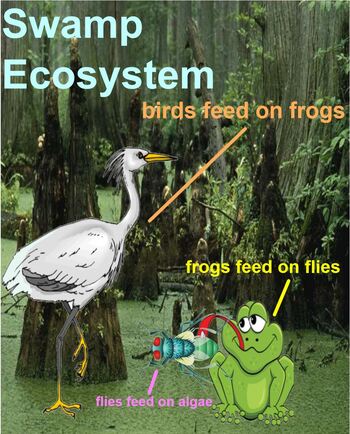
For this part of the activity, you will create a poster to serve as a visual representation of one of the rainforest’s ecosystems. To be successful, follow these steps:
- Choose which ecosystem you will study.
- Practice strong research skills as you go online to gather information about the plants and animals that live in your chosen ecosystem. Because plants and animals vary in rainforests around the globe, choose your search terms wisely. Make sure that you are focusing on the rainforest of Central America.
- Try to visualize what the relationships of plants and animals within your ecosystems might look like.
- On an 11"X17" piece of paper, create a poster on which you draw and label the plants and animals and state how they relate to one another. Be specific.
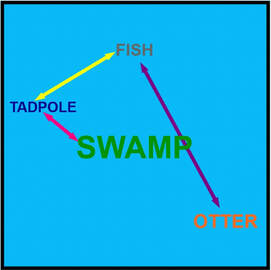
For Example: In the examples above and to the left you can see posters that depict a "swamp" ecosystem. With swamp as an ecosystem, “swamp” might be at the very center of an ecosystem poster. With “swamp” at the center of a swamp ecosystem picture, closest to the center might be algae, followed by an algae-eating fly. Next would come a fly-eating frog, and the outermost symbol may describe a frog-eating bird. You might add another set of relationships in the swamp ecosystem by beginning with tadpoles near the center, followed by a type of fish, then a fish-eating mammal, and so on.
Doing your Part - Part 2
Over time, animals adapt to their environment by developing traits that allow them to thrive in their environment. In the information above, you learned that the spots of jaguars help disguise them as they hunt for prey in the understory and how animals who live in the noise-dulling environment of the canopy layer have developed loud voices in order to communicate.
For this section, you will perform strong research to complete the chart below. Begin by choosing good search terms to gather information about three animals of your choice. NOTE: the animals you choose to study can come from any environment, not just the rainforest.
For this section, you will perform strong research to complete the chart below. Begin by choosing good search terms to gather information about three animals of your choice. NOTE: the animals you choose to study can come from any environment, not just the rainforest.
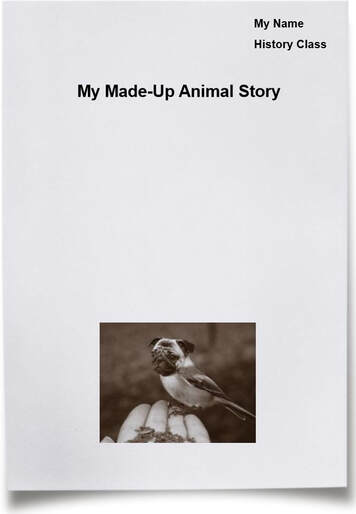
Now that you have an understanding of how animals adapt to their environment and the reasons they do so, I want you to use your knowledge of ecosystems and animals and have some fun.
For this part of your activity I want you to write a very short story (one paragraph is enough) in which you describe an ecosystem in detail and create an animal who thrives in your ecosystem. You may give your animals any traits you wish. Remember, however, that the traits you give your made-up animal should relate to their ability to thrive in the ecosystem you describe.
Please use detail-rich language to describe your ecosystem and your made-up animal. Make sure that you give your story an appropriate title and put your name on your story. You are welcome to include a picture of your made-up animal. Please print out your story and turn it in to me.
For this part of your activity I want you to write a very short story (one paragraph is enough) in which you describe an ecosystem in detail and create an animal who thrives in your ecosystem. You may give your animals any traits you wish. Remember, however, that the traits you give your made-up animal should relate to their ability to thrive in the ecosystem you describe.
Please use detail-rich language to describe your ecosystem and your made-up animal. Make sure that you give your story an appropriate title and put your name on your story. You are welcome to include a picture of your made-up animal. Please print out your story and turn it in to me.
Doing your Part - The Most Important Part
Human Impact - While animals change over time to adapt to their environment, humans more often adapt the environment to fit their needs. In ancient Mesopotamia, humans dug irrigation canals to create a fertile crescent of abundant crop production that allowed their civilization to grow. Seattle’s early non-native settlers cut down local forests, not just to build their own city but to build a quickly expanding San Francisco in the mid-19th century.
You may already be familiar with several ways that human activity impacts the environment. For this last geography activity, I want you to think about a specific biome or ecosystem and research what effect human activity has had on the biome or ecosystem you choose.
Usually, when we think of human impact on the environment we think of only the negative impact. However, there are countless individuals working around the globe to make sure that our impact is more positive. The difference one person makes can be inspirational to others. Because of that, I want you to come up with a plan to make a difference, and I want you to track your success over the course of just one week in the chart below.
You may already be familiar with several ways that human activity impacts the environment. For this last geography activity, I want you to think about a specific biome or ecosystem and research what effect human activity has had on the biome or ecosystem you choose.
Usually, when we think of human impact on the environment we think of only the negative impact. However, there are countless individuals working around the globe to make sure that our impact is more positive. The difference one person makes can be inspirational to others. Because of that, I want you to come up with a plan to make a difference, and I want you to track your success over the course of just one week in the chart below.

